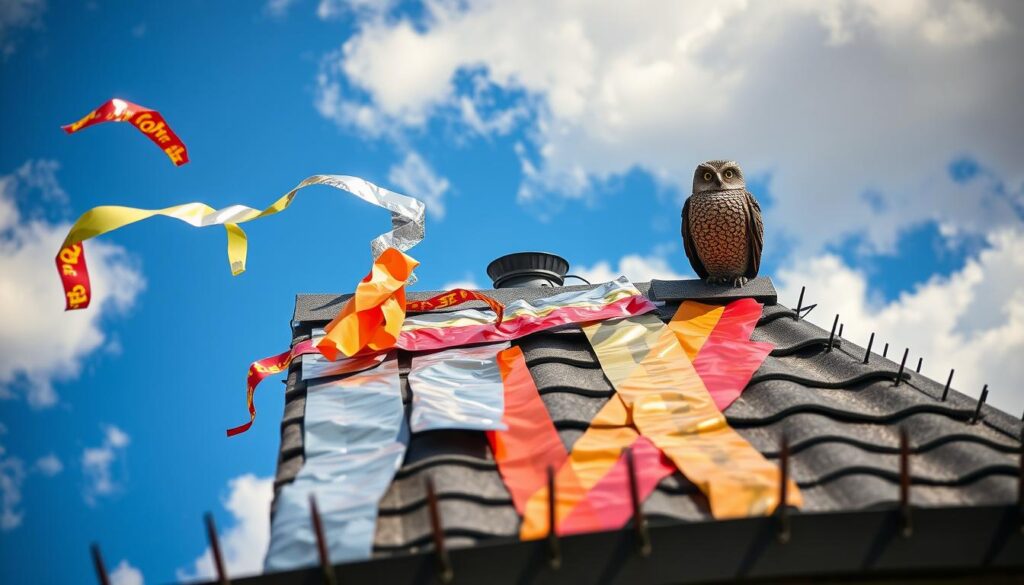Birds on roofs can spread over 60 diseases to humans. Their droppings can also harm your roof and gutters, leading to expensive fixes. It’s important to keep your home safe from birds.
In this guide, we’ll show you how to scare birds away from your roof. We’ll cover ways to stop them from nesting there too.
Key Takeaways
- Bird droppings can transmit over 60 zoonotic diseases to humans, posing health risks
- Acidic bird droppings can damage roofing materials and cause water damage
- Common roof-nesting birds include pigeons, starlings, sparrows, and mynas
- Visual deterrents, sound-based solutions, and physical barriers can effectively scare birds away
- Professional bird control products and services may be necessary for severe infestations
Understanding the Bird Problem on Your Roof
Roof-nesting birds can be a big problem for homeowners and building managers. Birds like pigeons, seagulls, starlings, sparrows, and mynas often choose rooftops for their nests. Knowing why they do this is key to humanely deter birds from roof and to use roof bird proofing methods.
Common Bird Species That Nest on Roofs
- Pigeons
- Seagulls
- Starlings
- Sparrows
- Mynas
Signs of Bird Infestation
Spotting a bird infestation on your roof is the first step to fix it. Look for big groups of birds, nest debris, lots of bird droppings, and bird sounds.
Why Birds Choose Your Roof
Rooftops offer space, food, and safety from predators. This makes them a great spot for birds. Tall buildings are especially appealing to birds looking for a high spot. Knowing why birds pick your roof helps you create good bird-safe roof protection plans.
“Implementing a comprehensive roof bird proofing plan is essential to maintaining the integrity of your property and ensuring the safety of your family or tenants.”
Health Risks Associated with Roof-Nesting Birds
Birds nesting on your roof can be a health risk. They carry diseases like Cryptococcosis, Psittacosis, and Histoplasmosis. These can spread through their droppings or dust.
Cryptococcosis is a lung disease from pigeon and starling droppings. It can be deadly if not treated. Psittacosis, or parrot fever, is a lung infection from bird feces. It causes fever and cough. Histoplasmosis is a fungus in bird droppings that can be fatal.
These risks are higher for the elderly, young kids, and those with weak immune systems. Birds can also bring parasites like bed bugs and ticks. These can infest your home and attract more pests.
“A Canadian woman contracted cryptococcal meningitis from pigeon feces, resulting in blindness.”
To keep your family safe, use bird control methods and non-lethal bird deterrence. Remove food sources and block entry points. Regular cleaning can also help prevent these health risks.
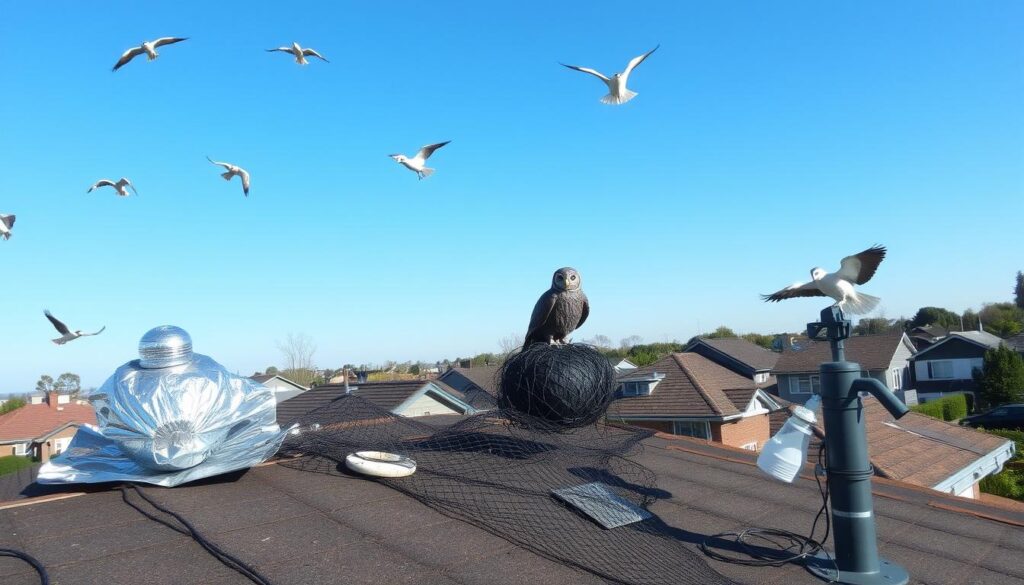
How Birds Can Damage Your Roof and Home
Birds nesting on your roof can cause more harm than just being a nuisance. Their droppings, nesting materials, and presence can lead to serious damage. This includes structural damage, fire hazards, and costly repairs if not addressed.
Structural Damage from Droppings
Bird droppings are very acidic. This can shorten a roof’s lifespan if exposed to them often. Studies show that this can decrease the roof’s lifespan over time.
The acidic nature of the droppings can also harm other rooftop elements. This includes solar panels and air conditioning units.
Gutter and Drainage Issues
Nests in gutters can block water flow. This causes water to seep behind the gutters or pool on the roof. A pool of water on the roof can lead to leaks, mold, mildew, and wood rot.
This further weakens the structure of your home.
Fire Hazards from Nesting Materials
Bird nests made of straw, leaves, and sticks can be flammable. If near HVAC units, chimneys, or ventilation systems, they pose a serious fire risk. This risk increases if the nests are left to dry out.
It’s important to protect your roof from birds to avoid these damages. Using effective roof bird proofing strategies can help prevent birds from nesting on roof. This will keep your property safe.
Legal Considerations Before Bird Removal
Homeowners and property managers need to know the laws about removing birds from roofs. Many bird species are protected by laws like the Migratory Bird Act in the U.S. and the Migratory Birds Convention Act in Canada. These laws make it illegal to disturb or remove nests, eggs, and birds without the right permits.
Before trying to control birds, it’s important to check local laws and talk to wildlife experts or bird control services. Breaking these laws can lead to big fines and legal trouble. Always choose humane and ethical ways to bird control methods that deter birds from roof areas.
| Legal Consideration | Explanation |
|---|---|
| Migratory Bird Act | This federal law prohibits the removal or disturbance of migratory bird nests and eggs without proper permits. |
| Local Regulations | Many states and municipalities have additional laws governing the management of nuisance birds, including specific requirements for nest removal. |
| Endangered Species | Certain bird species, such as the Peregrine Falcon, may be protected under the Endangered Species Act, requiring specialized permits for any control efforts. |
Talking to local wildlife agencies or professional bird control services is key. It helps ensure you follow all laws and regulations before using bird control methods to humanely deter birds from roof areas.
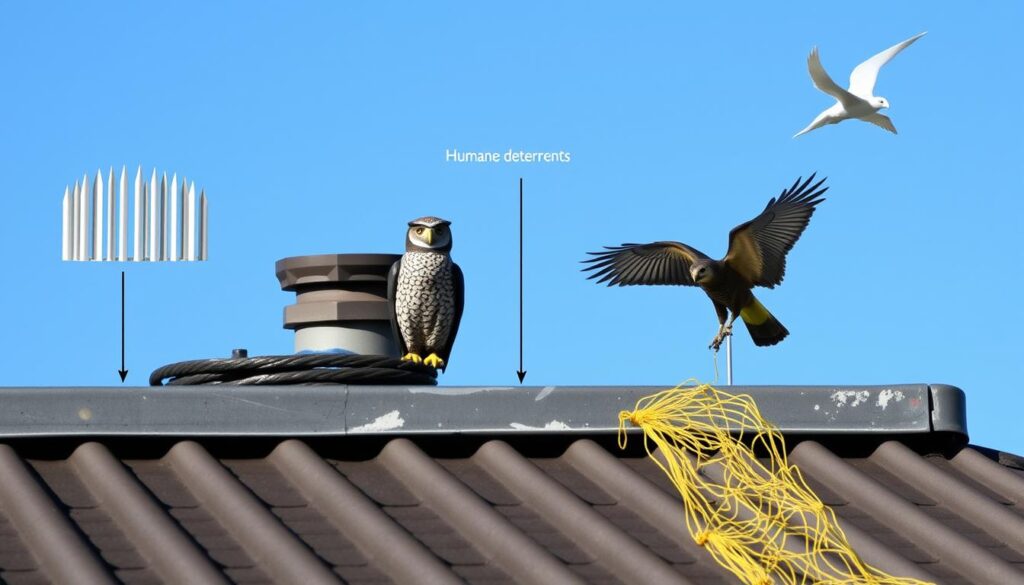
How to Scare Birds Away from Roof?
Dealing with birds on your roof can be frustrating. But, there are many scare tactics for birds and bird deterrents for roofs to help. You can use visual, sound-based, and physical barriers to keep them away.
Visual Deterrents
Reflective objects are a popular bird repellent. CDs, tin foil, or objects that look like predator eyes can scare birds. They think it’s dangerous and look for other places to nest.
Sound-Based Solutions
Sound can also scare birds away. Playing predator calls or warning sounds can chase them off. Some people use ultrasonic devices that birds can hear but humans can’t.
Physical Barriers
Physical barriers like bird spikes and wire systems can stop birds from landing. They make it hard for birds to find a place to perch. Using different methods together can work better, as birds may get used to one way.
Being consistent and using different methods is key to scaring birds away from your roof. A mix of tactics can keep birds off and protect your roof.
Professional Bird Control Products and Solutions
Professional-grade products are the best for keeping birds off your roof. They are made to handle many bird types and behaviors. This keeps your property safe and bird-free.
Stainless steel bird spikes make it hard for birds to land. Gutter bird spikes fit into gutters to stop nesting. Bird wire systems block big birds like pigeons and seagulls without harming them.
The Bird Jolt Flat Track electric system gives a mild shock to scare birds away. It works on different bird sizes and can be tailored to your needs.
| Product | Key Features | Warranty |
|---|---|---|
| Stainless Steel Bird Spikes | Durable, UV-resistant design | 10 years |
| Gutter Bird Spikes | Fits securely in gutters | 10 years |
| Bird Wire System | Effective against pigeons and seagulls | N/A |
| Bird Jolt Flat Track | Stops all bird species, customizable colors | N/A |
SpectrumV Holographic Bird Gel and Reflect-A-Bird Deterrents use light and sound to scare birds. They need regular upkeep to work well.
Not sure what bird control to use? Talk to Bird B Gone experts for advice. They offer safe, humane products to keep birds away from homes and businesses.
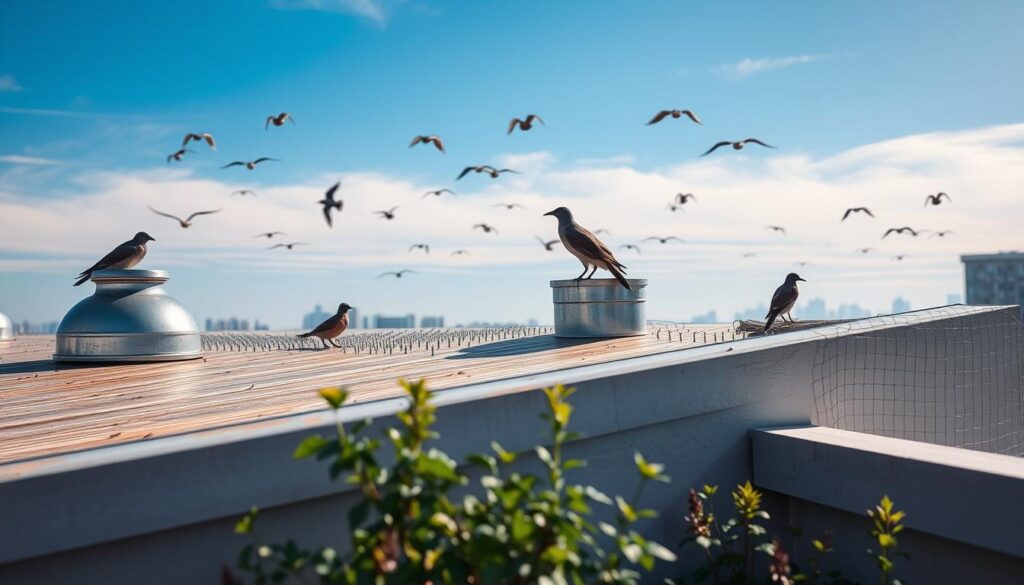
Natural and Humane Bird Deterrent Methods
There are many natural ways to keep birds off your roof. These methods are safe for both your property and the birds. Let’s look at some effective natural ways to scare birds away.
Environmental Modifications
To keep birds away, make your roof and area less inviting. Here are some ways to do it:
- Secure garbage cans and control insects to remove food sources
- Remove birdbaths and standing water to block water sources
- Trim trees and shrubs near the roof to stop nesting
Predator Decoys
Predator decoys, like plastic owls or hawks, can scare birds. Move them often to keep them effective. Adding sound or motion can make them even better.
“Decoys like owl, raven, and falcon statues can scare off a variety of birds.”
Using these humane methods can keep birds off your roof. Stay alert and check how well they work. This way, you can keep your roof bird-free without harming them.
Installing Bird Spikes and Anti-Roosting Strips
Bird spikes and anti-roosting strips are great for keeping pigeons and seagulls off your roof. They make the surface uneven, which birds don’t like. This stops them from landing and nesting.
Bird spikes work really well to keep birds away. They should be 6 inches apart and 2-3 inches deep. This makes landing uncomfortable for birds. Metal spikes last longer than plastic, but plastic is cheaper.
Anti-roosting strips are another good choice for bird deterrents. They make the surface slippery, so birds can’t get a grip. They’re great for places like gutters and eaves.
Both spikes and strips come in different colors and sizes to match your roof. But, covering a lot of area can be expensive and hard work. For the best roof bird proofing, use a mix of methods.
| Product | Effectiveness | Durability | Cost |
|---|---|---|---|
| Metal Bird Spikes | High | High | High |
| Plastic Bird Spikes | High | Moderate | Low |
| Anti-Roosting Strips | Moderate | High | Moderate |
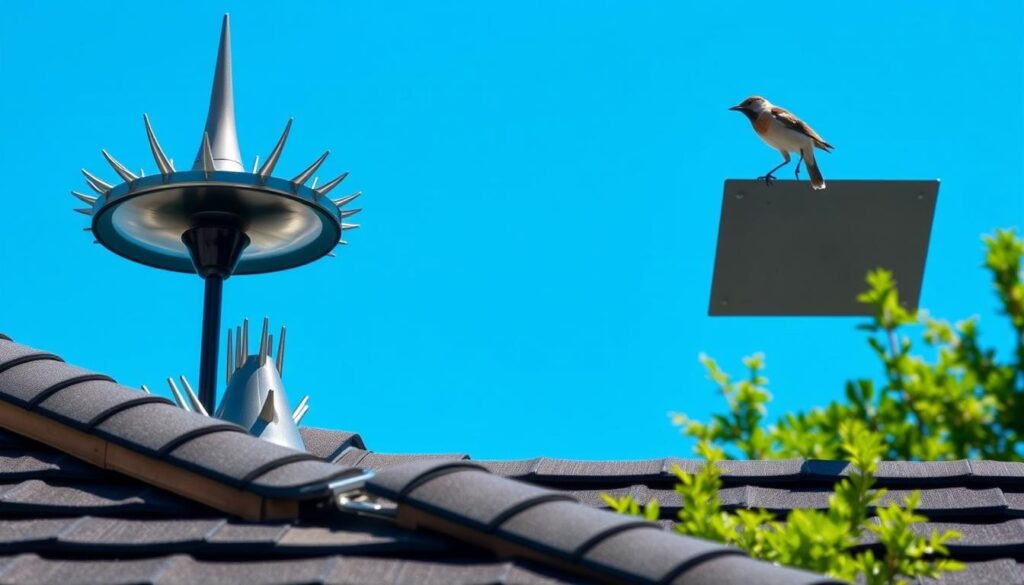
“Bird spikes are a reliable and humane way to keep birds off your roof and protect your property from damage.”
Maintenance Tips to Prevent Bird Nesting
Keeping your roof in good shape is key to stopping birds from nesting and damaging your home. Regular checks and quick actions can help keep your place bird-free.
First, fix any holes, gaps, or “ponding” issues on your roof. These spots are perfect for birds to make nests. Also, make sure to secure or remove any loose gravel on flat roofs. Birds might find it useful for nesting.
If a hawk or owl has visited, clean up any leftovers or droppings right away. Leaving them can attract more birds, thinking it’s a safe spot. Also, fix any insect infestations on your roof. Birds might come for the food.
For roofs with acrylic coverings on spray polyurethane foam, keep them in good shape. When they’re damaged, birds might see them as a good place to nest.
- Regularly inspect and seal any gaps or holes in your roof to prevent bird entry.
- Secure or remove loose gravel on flat roofs to discourage birds from nesting.
- Clean up after predator visits to avoid attracting more birds to the area.
- Address any insect infestations promptly, as they can draw in nesting birds.
- Maintain and repair acrylic coverings on spray polyurethane foam roofs to prevent birds from nesting.
By being proactive with roof care and fixing things that attract birds, you can prevent birds from nesting on your roof. This way, you protect your home from bird damage and keep it safe.
Chemical and Gel Repellents for Bird Control
Chemical and gel repellents can help keep birds off your roof. These products make surfaces uncomfortable or release smells and tastes that birds don’t like. This keeps them from nesting or roosting on your property.
Types of Bird Repellents
Popular chemical repellents include sprays like Avian Control™ and Avian Migrate. They use methyl anthranilate (MA) to repel birds. These sprays can cover areas from 4 acres to 16,000 square feet per gallon.
Another option is Avian Fog Force™ TR Bird Repellent. It uses a 14.5% MA solution to keep birds away from a 42,000 cubic foot area for about 30 days.
Gel-based repellents, like SpectrumV Holographic Bird Gel, are also used. These gels are sticky and clear, making surfaces slippery for birds. But, they need to be replaced every few months to work well.
Application Methods
Applying these repellents is different. Liquid sprays are sprayed directly on surfaces like roof edges and gutters. Gels are glued down with silicone adhesive to last longer.
While these repellents work, using them with other bird control methods is best. Regularly applying and maintaining them is key to keeping birds off your roof.
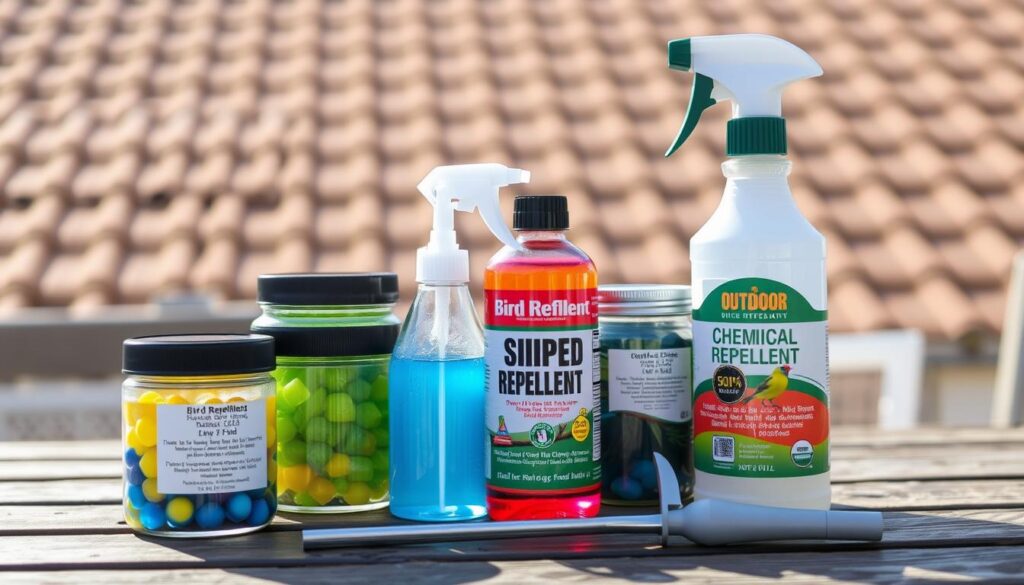
| Product | Active Ingredient | Coverage Area | Reapplication Frequency |
|---|---|---|---|
| Avian Control™ | 20% MA | 4 acres per gallon | 7-14 days |
| Avian Migrate | 14.5% MA | 16,000 sq ft per gallon | 7-14 days |
| Avian Fog Force™ TR | 14.5% MA | 42,000 cubic feet | 30 days |
| SpectrumV Holographic Bird Gel | N/A | Spot treatment | Few months |
When to Call Professional Bird Control Services
Some homeowners try DIY bird control, but there are times when professionals are better. This is true for big bird infestations, issues with protected bird species, or when DIY doesn’t work.
Professional bird control experts can spot the bird problem and know how big it is. They have the right tools and knowledge to fix it without breaking the law. They also plan for the future to stop bird problems from coming back.
For tricky setups like electric tracks or big nets, pros are a must. These setups need careful planning and doing. Homeowners might not have the skills for this, so calling a pro is smart.
| Scenario | Recommended Action |
|---|---|
| Large-scale bird infestations | Call professional bird control services |
| Dealing with protected bird species | Call professional bird control services |
| DIY methods prove ineffective | Call professional bird control services |
| Complex bird deterrent installations | Call professional bird control services |
Getting help from professional bird control experts can solve bird problems. It ensures you follow the law and keeps your property safe.
Long-Term Prevention Strategies
To keep birds off your roof, you need a long-term plan. Start by setting up a regular check-up schedule. Look for places where birds might nest and fix them before they start.
Make sure to check gutters, eaves, and other spots birds like. Seal any holes or cracks to keep them out. This stops birds from making your roof their home.
Tell everyone in your household not to feed birds near your home. This makes your roof less attractive to them. You can also change your landscaping to make it less bird-friendly.
Try different ways to keep birds away, like bird spikes or netting. Change these methods often to keep birds guessing. With regular upkeep, changing your yard, and using bird-safe roof protection, you can keep birds off your roof for good.
FAQ
What are the common bird species that nest on roofs?
Birds like pigeons, seagulls, starlings, sparrows, and mynas often nest on roofs.
What are the signs of a bird infestation on a roof?
Look for large bird gatherings, nest debris, and lots of droppings. You might also hear birds.
Why do birds choose to nest on roofs?
Roofs offer food, water, and safe places to nest. They also protect birds from predators.
What health risks are associated with roof-nesting birds?
Birds can spread over 60 diseases. Their droppings, feathers, and secretions can be harmful. This is especially true for the elderly, young kids, and those with weak immune systems.
How can birds damage a roof and home?
Bird droppings can harm roofing materials and solar panels. Nests in gutters can cause water buildup. Nests in chimneys can block airflow and pose fire risks.
What legal considerations should be taken before removing birds from a roof?
Laws like the Migratory Bird Act protect many birds and their nests. Removing nests or eggs without a license is illegal.
What visual deterrents can scare birds away from a roof?
Use reflective items like CDs, tin foil, and round objects that look like predator eyes.
What sound-based solutions can deter birds from a roof?
Play predator calls or warning sounds to scare birds away.
What physical barriers can prevent birds from landing on a roof?
Use bird spikes, anti-roosting strips, and bird wire systems to keep birds off.
What professional-grade products are available for bird control on roofs?
High-quality products include stainless steel spikes, gutter spikes, and bird wire systems. Electric systems like Bird Jolt Flat Track give a mild shock to birds.
What are some natural and humane deterrent methods for keeping birds off a roof?
Remove food and water sources. Secure garbage and manage insects. Use decoys like plastic owls or hawks.
How can bird spikes and anti-roosting strips be effectively installed on a roof?
Install with strong adhesive or screws. Gutter spikes use thumb screws for easy setup.
What roof maintenance tasks can help prevent birds from nesting?
Fix holes and gaps. Secure or remove loose gravel. Clean up after predators and address insect issues quickly.
What types of chemical and gel repellents are available for bird control on roofs?
Use gels and sprays that make surfaces uncomfortable for birds. SpectrumV Holographic Bird Gel works for all species but needs frequent replacement.
When should professional bird control services be considered?
Call experts for big infestations, protected species, or when DIY fails. They can solve the problem legally and effectively.
